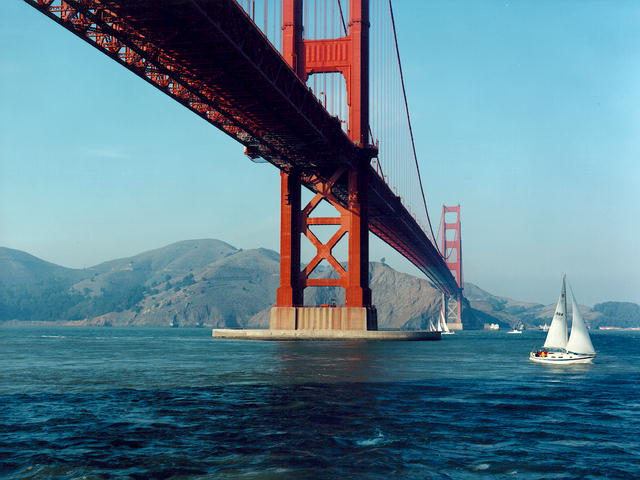

 |

|

|
|
The Golden Gate Bridge links San Francisco with Marin
County in absolute splendor. The bridge is one of the architectural marvels
of the Twentieth Century and a testament to human strife, as it was
constructed during the years of the Great Depression. For years, the Golden
Gate Bridge held the title as the longest suspension bridge in the world.
Before its completion in 1937, the bridge was considered impossible to build, due to persistently foggy weather, 60-mile-per-hour winds, and strong ocean currents, which whipped through a deep canyon below. In fact, the bridge is commonly known as the "Bridge that couldn't be built." Despite these unforgiving natural elements, the bridge was constructed in a little more than four years. The total cost was $35 million. The total length of the bridge spans 1.2 miles. Eleven men lost their lives during the construction of the bridge. Even today, the massive spans of the bridge are often shrouded in fog. The bridge sways 27 feet to withstand winds of up to 100 miles per hour. International Orange was the color chosen for the bridge because it blended well with the bridge's natural surroundings. The two great cables extending from the bridge contain 80,000 miles of steel wire, which is enough to circle the equator three times. The concrete poured to cement the bridge into the stormy waters below could have also been used to pave a five-foot sidewalk from New York to San Francisco. Because of the Golden Gate Bridge, San Francisco is one of the premier skyline cities in the nation. It was a triumphant day in the history of the city when the bridge was completed on May 27, 1937. Over 200,000 people celebrated the grand opening of the Golden Gate Bridge by walking its length. The following day, a dedication ceremony was held to officially christen what would become the architectural trademark of the city. The regular flow of vehicular traffic began the next day. Efforts to begin the construction on the bridge began as early as 1928. The process would entail the efforts of six counties in Northern California. In 1928, the counties formed a Golden Gate Bridge and Highway District. In 1930, the voters appropriated a $35 million bond issue to finance the building of the bridge. For many years following, Joseph Baerman Strauss, a distinguished engineer, dreamed of raising a span across the Golden Gate. It was in response to his vision that people first started saying that the bridge could not be built. But, amazingly enough, Strauss held fast to his vision, and a span was eventually raised across the Golden Gate Bridge. The actual work on the bridge began on January 5, 1933. It was completed four-and-one-half years later. The result astounded the fiercest of Strauss's critics. To this day, the bridge is admired for its magnitude and beauty. The bridge is nothing short of a powerful force meant to combat nature. The often mighty winds from the Pacific Ocean are sustained by a mid span swing of 27 feet. The two towers of the bridge rise an impressive 746 feet, which is 191 feet taller than the Washington Monument. The pier of the bridge is only 1,215 feet from the shore, the distance between the two towers that support the cables, which in turn, support the floor of the bridge is 4,200 feet. These two cables are the largest bridge cables ever made at a little over 3.61 feet in diameter. Today, pedestrians and bicyclists are still allowed to cross the bridge on pathways with breathtaking views of the city, Alcatraz, and the Marin Headlands. The bridge toll for vehicles is $5 when entering San Francisco. The first exit of the Marin side of the bridge is Visa Point, which provides a magnificent view of the San Francisco skyline. But, the best way to view the bridge is to walk across. This usually takes about an hour. |
CAN'T FIND WHAT YOU'RE LOOKING FOR? CLICK HERE!!!